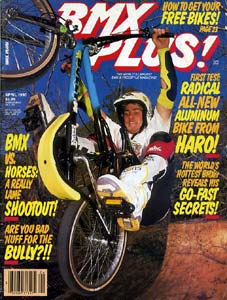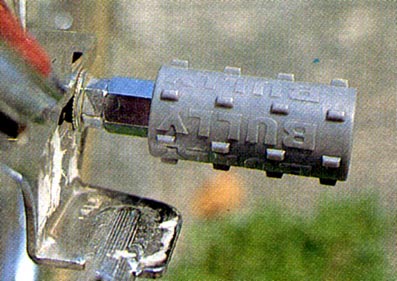bullybmxhistory.webs.com, 2013: R.L. Osborn was a pro flatland rider throughout the '80s, and a successful one at that. By age 25, in 1988, he was worth a million dollars, but seemed to sense that he was in the autumn of his pro career. While riding for General Bicycles in '88, Osborn founded Hammer Bodywear, which manufactured neoprene knee and shin pads, along with a full clothing line. Hammer took off, and Osborn was reportedly doing so well with the brand that he left his sponsorship with General (which netted him $100,000 a year) to focus on Hammer. Osborn also recognized the changing tides of the BMX freestyle scene, and adjusted his image to reflect BMX's embracing of "street." Osborn stopped wearing uniforms, started riding street more and paid to get hair extensions alongside former General team mate Chris Rothrock. To accompany the change in image, Osborn, who was reportedly making $350,000 a year in 1989, started Bully Bicycles. Bully launched quickly, advertising in the magazines of the time and sponsoring some of the more influential riders of the time, including vert pros Mike Dominguez and Simon Tabron, street pioneers Vic Murphy and Craig Campbell, Nor Cal park/street riders Mike Kranich and Danny Schow, and pro flatlander Perry Mervar.
FIRST RUNS OF FRAME.
bullybmxhistory.webs.com, 2013: Admittedly not the strongest bikes of the time, Bully issued frames, forks, bars, stems and accessories from the start. But more than anything, Bully's iconic stamp on BMX was left with their first runs of frames. Based around an integrated bashguard which featured a nylon "skid plate," the Bully frames featured two-tone paint jobs, original graphics from BMX rider Marc McKee (who would later go on to work for skate brand World Industries), an integrated seat clamp and one of the more relaxed seat tube angles to exist on a BMX bike. At the time, the bikes were far from practical, but that didn't matter. Bully took off, and riders ate it up. Although the frames broke easily, the image was just what everyone wanted, and perhaps without realizing it, Bully had more appeal to the average BMXer because it was technically rider-owned (unlike GT and Haro, who were also producing bashguard bikes at the time.)
Bully's popularity continued to grow into the new decade. Their line extended to include traditional, bashguard-less frames, complete bikes, gimmicky bar and stem combos (the T-bar, later spoofed by S&M), a video ("Slow Ride") and summer tours. New riders were introduced to the team as well, including Canadian Jay Miron, vert rider Jon Byers, flatland Pete Brandt and dirt legend Todd Lyons.
And then, the unexpected happened. As quickly as Bully rose in popularity, the brand waned. For years, I figured that R.L. Osborn walked away from Bully for reasons relating to the quality of the product. Turns out, I was wrong. A few circumstances led to Osborn's eventual sale of Bully and Hammer. He missed riding. "It was really hard to ride and run the company, because your head was so in the business all the time, and then you have to stop that and go out and ride and try to be good. And I think that's when I started fading out of riding pro -- when I started getting more into the business," Osborn said in the 2008 Freestylin' book Generation F. The momentum has disappeared. "The sport was slowing down at the same time, and the economy was in the can, and it was that whole thing of energy not being there -- lack of money for the sport. The sales were going down and the economy got worse, so it was hard," Osborn added. And R.L. was done with the bike industry. "I just couldn't sell my soul anymore. I spent my life building my name to run that business, and make a living off of it, but after a while, when you know the inside of the industry, you see who's screwing who, who's ripping off who, and you're afraid to come out with a new design, because the bigger companies will have it reproduced," he continued. In 1991, Bully and Hammer were sold to MCS in Florida, and R.L. returned to riding. "The plan was to go back and ride by myself as an unknown and that's exactly what I did. The path I took out of the bike industry was not the smartest financial move, and I knew that," he says.
Bully continued on, and sponsored notable pros such as Kevin Porter, Leigh Ramsdell, Mike Aitken, Mark Flippowicz and Cory Nastazio in the late '90s, but about the only thing that carried over from the first incarnation of Bully was the name. The graphics, bikes and general feel of the brand had changed with the times.
Still, to this day, the influence of R.L. Osborn and Bully Bicycles remains. Riders may not have the greatest memories of strong frames built to withstand the abuses of street riding, but the look, feel and ethos behind Bully Bicycles at the turn of the '90s helped to kickstart a rider-owned revolution that brought BMX freestyle into the next generation. Respect is due to R.L. Osborn.
Founder: RL Osborn
RL Osborn vient de mettre au point avec MCS un nouveau vélo plus approprié au street et au free. Le nom du vélo: Bully.
Bicross and Skate magazine mai 1990: Ce vélo apporte légèreté et bonne géométrie mais il est très peu solide, les pattes arrières sont trop fines et il n'a pas de tirage central.
Bully pegs.
Invert august 1990: Pegs fresh from Bully. And the weird thing is, they are made out of very hard dense plastic, with a steel centre. A good size, very grippy as there are large studs on the surface. They'd be good for grinding too. Hot stuff.

Mike Dominguez on his new ramp in Devore, CA. on the cover of BMX Plus! april 1990.


UK distributor: Split Second Imports.
Powerforks using a cantilever front brake.

Pete Brandt 1992 - ....
Jon Byers 1990 - 1991
Invert august 1991: Jon is now off Bully and now on WAL.
Craig Campbell 1990 - ....
Chris Day 1995
Mike Dominguez 1989 - ....
Jody Donelly 1995-1996
Scott Freeman 1990-1992
Bob Kohl spring 1993 - ....
Mike Kranich 1989 - 1991
Eben Krakau .... - 1991
Invert august 1991: Eben Krakau is off Bully and now riding for WAL.
Todd Lyons 1991 only.
Ron McCoy 1989
Perry Mervar 1990 - ....
Jay Miron 1991
Invert february 1991: Jay Miron is off Wilkerson airlines and riding for Bully.
Invert august 1991: Jay Miron is off Bully and on GT.
Vic Murphy 1989 - ....
Cory Nastazio 1997 - january 1998
Chris Poulos 1991
Dialed flatland pro of Rhode Island Chris Poulos who just won the 1991 freestyle world championships in Denmark and the NBL Nationals in Kentucky is now riding for Bully.
Leigh Ramsdell December 95, Leigh is swithing from 2-Hip bikes over to Bully
Chris Rothrock 1989
Danny Schow 1989 - 1991
Simon Tabron january 1990 - ....
Mike Tagliavento 1995